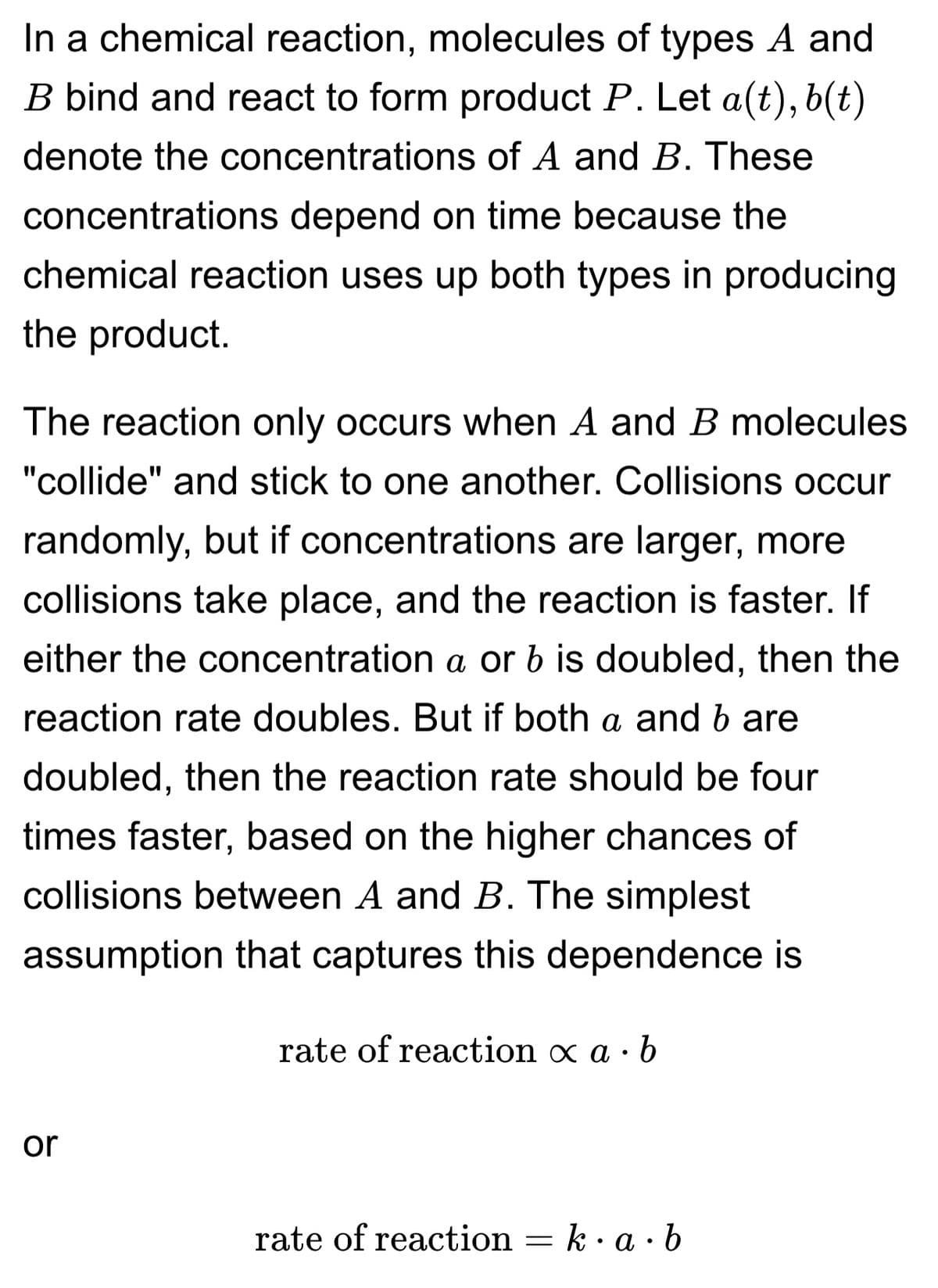Why does the product (a•b), rather than the sum (a + b) appear in the Law of Mass Action? This is sometimes brought up to demonstrate how/why nonlinear terms arise in differential equations. The law of mass action states that The rate of a chemical reaction involving an interaction of two or more chemical species is proportional to the product of the concentrations of the given species. This is NOT an assignment...I'm just curious and trying to understand mathematical relations better. Thanks!
Why does the product (a•b), rather than the sum (a + b) appear in the Law of Mass Action? This is sometimes brought up to demonstrate how/why nonlinear terms arise in differential equations. The law of mass action states that The rate of a chemical reaction involving an interaction of two or more chemical species is proportional to the product of the concentrations of the given species. This is NOT an assignment...I'm just curious and trying to understand mathematical relations better. Thanks!
Chemistry: Principles and Reactions
8th Edition
ISBN:9781305079373
Author:William L. Masterton, Cecile N. Hurley
Publisher:William L. Masterton, Cecile N. Hurley
Chapter11: Rate Of Reaction
Section: Chapter Questions
Problem 35QAP: Azomethane decomposes into nitrogen and ethane at high temperatures according to the following...
Related questions
Question
Why does the product (a•b), rather than the sum (a + b) appear in the Law of Mass Action?
This is sometimes brought up to demonstrate how/why nonlinear terms arise in differential equations. The law of mass action states that The rate of a
This is NOT an assignment...I'm just curious and trying to understand mathematical relations better. Thanks!

Transcribed Image Text:In a chemical reaction, molecules of types A and
B bind and react to form product P. Let a(t), b(t)
denote the concentrations of A and B. These
concentrations depend on time because the
chemical reaction uses up both types in producing
the product.
The reaction only occurs when A and B molecules
"collide" and stick to one another. Collisions occur
randomly, but if concentrations are larger, more
collisions take place, and the reaction is faster. If
either the concentration a or b is doubled, then the
reaction rate doubles. But if both a and b are
doubled, then the reaction rate should be four
times faster, based on the higher chances of
collisions between A and B. The simplest
assumption that captures this dependence is
or
rate of reaction x a. b
rate of reaction =
k.a.b
Expert Solution
This question has been solved!
Explore an expertly crafted, step-by-step solution for a thorough understanding of key concepts.
Step by step
Solved in 3 steps with 2 images

Recommended textbooks for you

Chemistry: Principles and Reactions
Chemistry
ISBN:
9781305079373
Author:
William L. Masterton, Cecile N. Hurley
Publisher:
Cengage Learning

Chemistry: The Molecular Science
Chemistry
ISBN:
9781285199047
Author:
John W. Moore, Conrad L. Stanitski
Publisher:
Cengage Learning

Introduction to General, Organic and Biochemistry
Chemistry
ISBN:
9781285869759
Author:
Frederick A. Bettelheim, William H. Brown, Mary K. Campbell, Shawn O. Farrell, Omar Torres
Publisher:
Cengage Learning

Chemistry: Principles and Reactions
Chemistry
ISBN:
9781305079373
Author:
William L. Masterton, Cecile N. Hurley
Publisher:
Cengage Learning

Chemistry: The Molecular Science
Chemistry
ISBN:
9781285199047
Author:
John W. Moore, Conrad L. Stanitski
Publisher:
Cengage Learning

Introduction to General, Organic and Biochemistry
Chemistry
ISBN:
9781285869759
Author:
Frederick A. Bettelheim, William H. Brown, Mary K. Campbell, Shawn O. Farrell, Omar Torres
Publisher:
Cengage Learning

General, Organic, and Biological Chemistry
Chemistry
ISBN:
9781285853918
Author:
H. Stephen Stoker
Publisher:
Cengage Learning

Chemistry for Engineering Students
Chemistry
ISBN:
9781337398909
Author:
Lawrence S. Brown, Tom Holme
Publisher:
Cengage Learning

Introductory Chemistry: A Foundation
Chemistry
ISBN:
9781337399425
Author:
Steven S. Zumdahl, Donald J. DeCoste
Publisher:
Cengage Learning